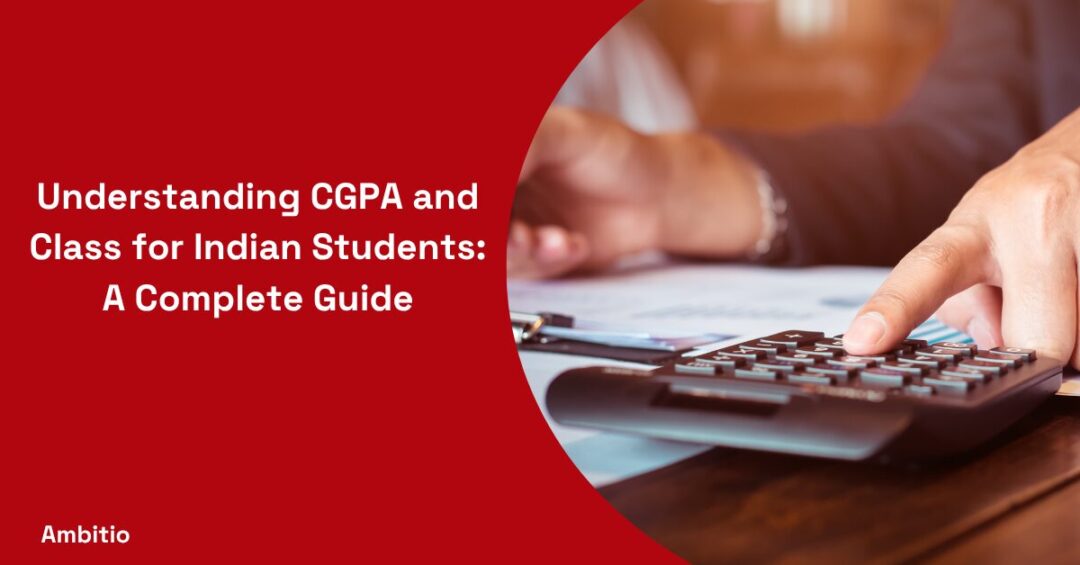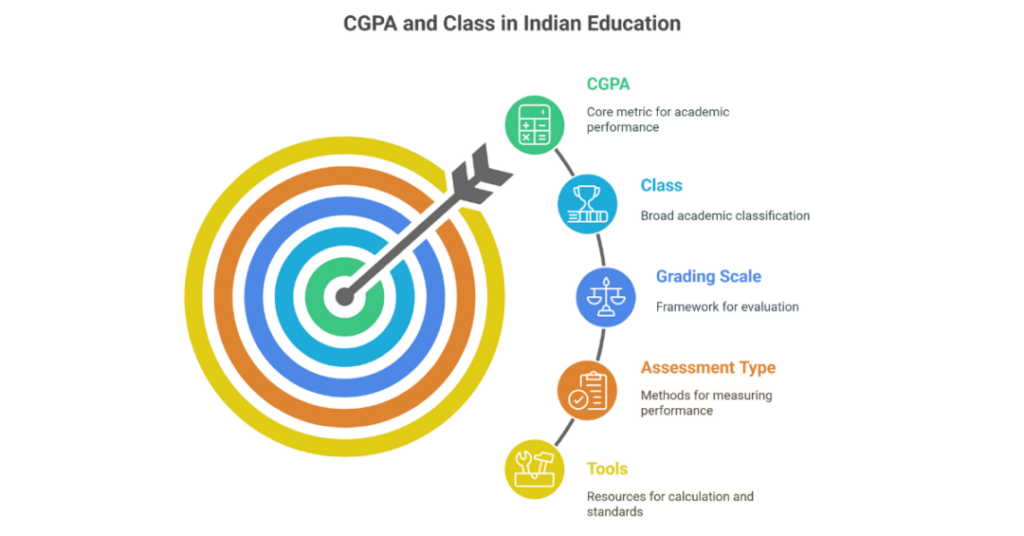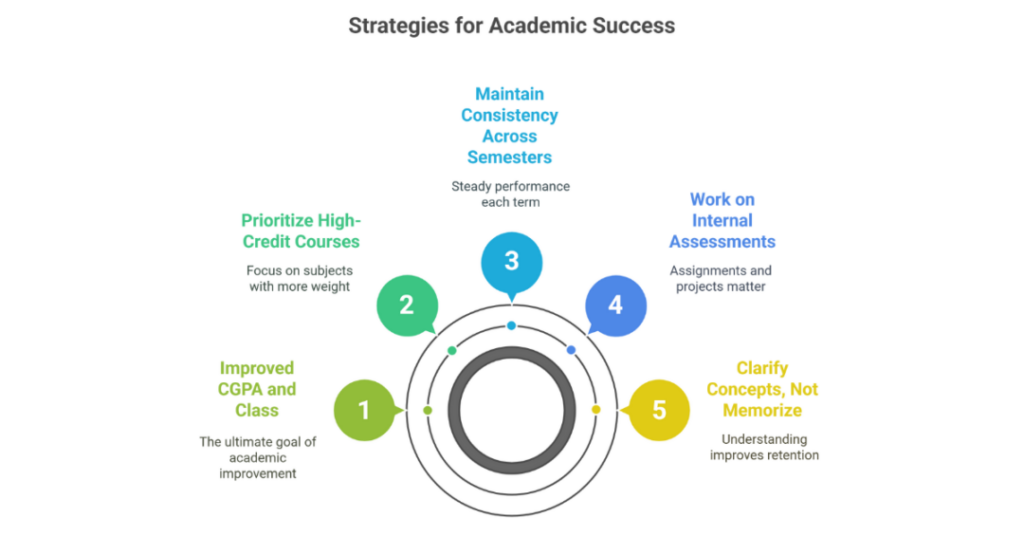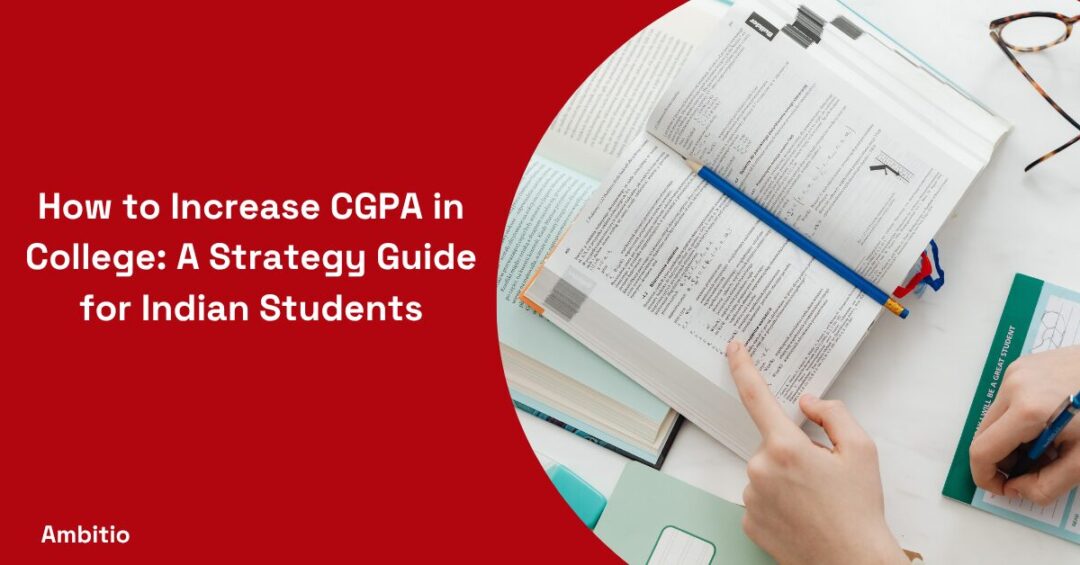7 July 2025
5 minutes read
Understanding CGPA and Class for Indian Students: A Complete Guide

Key Takeaways
- CGPA and class are often misunderstood but are key to academic standing, study abroad eligibility, and university applications.
- CGPA is a precise score based on credit-weighted performance, while class offers a broader classification like First Class or Distinction.
- Improve your academic profile by focusing on high-credit subjects, mastering internal assessments, and following a steady study plan.
Did you know that over 70% of Indian students misunderstand how CGPA and class impact their academic standing and study abroad prospects? Many struggle with terms like grade point average, credit points, 10-point scale, or how to convert CGPA into percentage, especially when every semester adds pressure.
This confusion isn’t just technical; it affects real decisions like study schedule, course selection, or applying abroad. Knowing how to calculate CGPA and class the right way can drastically change your academic and professional trajectory.
What Is CGPA?
CGPA, or Cumulative Grade Point Average, is a crucial metric in the Indian grading system used to assess a student’s academic performance across semesters. It is calculated by dividing the total grade points earned in all courses by the total number of credits. The CGPA grading system, often based on a 10-point scale, converts letter grades into grade points to give a weighted average.
Unlike SGPA (Semester Grade Point Average), CGPA reflects overall academic standing. Understanding CGPA and class is essential for GPA converter, transcripts, study abroad applications, and improving your academic performance using tools like a CGPA calculator or conversion table.
Difference Between CGPA and Class in Indian Education System
In the Indian education system, CGPA and class are often confused but serve different purposes in evaluating a student’s performance. While CGPA focuses on precise grade-based calculations across semesters, class reflects broader academic classifications like “First Class” or “Distinction.”

Here’s a clear breakdown of the difference:
| Criteria | CGPA (Cumulative Grade Point Average) | Class (Classification) |
|---|---|---|
| Definition | A cumulative average of grade points obtained across all semesters. | A broad category of academic performance based on percentage or CGPA. |
| Basis | Calculated using CGPA formula: multiply grade points by credit, then divide the total by total credits. | Based on overall percentage or CGPA thresholds defined by UGC or universities. |
| Grading Scale Used | 10-point CGPA scale (commonly used GPA grading system in India). | Percentage range or CGPA bands (e.g., Distinction = >7.5 CGPA or >75%). |
| Assessment Type | Continuous assessment across courses taken, including assignments, exams, and semester GPAs. | Final classification after completing the programme. |
| Conversion | Can be converted to percentage using a CGPA to percentage conversion table or standard formula. | Derived from CGPA into a percentage, then classified into a class. |
| Tools | CGPA calculator, GPA calculation methods, formula involving weighted grade points and credit hours. | UGC classification standards or university-specific guidelines. |
| Example | 10 CGPA in percentage = 95% (varies by institution). | First Class, Second Class, Pass Class, etc. |
| Used For | Transcript records, report cards, GPA and CGPA conversions (especially for study abroad). | Mentioned in final academic documents and used in employment or higher education admissions. |
In short, while CGPA tells you “how much”, class tells you “how well”, both are critical for academic evaluations and opportunities abroad.
How CGPA Is Calculated in Indian Universities?
In Indian universities, CGPA and class are essential indicators of a student’s academic journey.
To get your CGPA, institutions follow a standard method that reflects your overall academic performance across semesters and courses.
Steps to Calculate CGPA:
- Multiply the Grade Points for each subject by the number of credit hours assigned.
- Sum the Product of all subjects in one semester – this gives you the weighted grade for that term.
- Repeat this for all semesters the university uses in the programme.
- Calculate the Total grade points earned across semesters and divide it by the total credit hours.
- The result is your Cumulative Grade Point Average (CGPA) – often reported on a 10-point scale, though some educational institutions use a 4-point GPA system for international equivalency.
Example:
Suppose in Semester 1, you took 3 subjects with the following:
- Subject A: Grade = 9, Credits = 3 → 9 × 3 = 27
- Subject B: Grade = 8, Credits = 4 → 8 × 4 = 32
- Subject C: Grade = 7, Credits = 3 → 7 × 3 = 21
Sum of the product = 27 + 32 + 21 = 80
Total credit hours = 3 + 4 + 3 = 10
CGPA = 80 / 10 = 8.0
To convert CGPA to GPA (4-point scale), many use:
GPA = (CGPA/10) × 4 → (8.0/10) × 4 = 3.2
This process is widely accepted in educational institutions and forms the basis of your cgpa and class classification.
What Does ‘Class’ Mean in Indian Academic Results?
In Indian academic results, “class” refers to the broad classification of a student’s academic performance based on percentage or CGPA. Unlike the precise number you get with CGPAs, a class groups students into categories like Distinction, First Class, Second Class, or Pass.
While CGPA and class both reflect academic achievement, class is more commonly used in degree certificates and job applications. It’s a simplified way for educational institutions to represent performance levels, especially when comparing CGPAs across different universities or programmes.
Convert CGPA to Percentage Calculation: What Indian Students Should Know
Many Indian students are confused about how to convert CGPA to percentage, especially when applying for jobs or study abroad programmes. Since different universities use different formulas, knowing the right method is crucial for accurate reporting.
Key Points Indian Students Should Know:
- Most Indian universities follow the UGC-recommended formula:
Percentage = CGPA × 9.5 - Some institutions have their own method, so always check your university’s official conversion guideline.
- This formula is typically used for a 10-point CGPA scale (common in CBSE and many Indian universities).
- CGPA and class often depend on your converted percentage for final classification.
- Use a reliable CGPA calculator or your marksheet instructions for precise results.
Example:
If your CGPA is 8.2, then:
Percentage = 8.2 × 9.5 = 77.9%
This means your performance likely falls under the First Class or Distinction category, depending on the institution’s grading policy.
How Foreign Universities Interpret CGPA and Class of Indian Students?
Foreign universities view CGPA and class as important indicators of an Indian student’s academic performance, but they often interpret them differently from Indian institutions. Since grading scales vary globally, universities abroad typically convert CGPA to their own GPA system to assess eligibility.
However, they also consider the class, like First Class or Distinction, as a contextual reference. Many institutions ask for official transcripts with grading policies attached to better understand both CGPA and class, ensuring fair evaluation during admissions or scholarship reviews.
5 Tips to Improve your CGPA and Academic Class
Improving your CGPA and class isn’t just about studying harder; it’s about studying smarter. Small strategic changes in your habits can create a big impact on your overall academic performance.

Here are 5 practical tips to increase your CGPA and class:
- Prioritize High-Credit Courses: Focus on subjects with more credit weight—they affect your CGPA the most.
- Maintain Consistency Across Semesters: A steady performance each term helps build a strong cumulative score.
- Work on Internal Assessments: Assignments, projects, and internal exams contribute significantly to your grades; don’t neglect them.
- Clarify Concepts, Not Just Memorize: Understanding leads to better retention and application, improving long-term performance.
- Follow a Realistic Study Schedule: Break your workload into manageable tasks with daily or weekly targets to avoid burnout and last-minute cramming.
Conclusion
Understanding your CGPA and class is more than just decoding academic jargon, it’s about unlocking global opportunities. Whether you’re planning to pursue higher education abroad or aiming to stand out in competitive applications, your academic profile speaks volumes. But don’t navigate this journey alone.
At Ambitio, we specialize in profile building for Indian students like you, turning transcripts into powerful stories that top universities notice.
Ready to convert your grades into global goals?
Book a free profile evaluation with Ambitio today and let’s build your dream future—one grade at a time!
FAQs
Q1: What is the difference between GPA and CGPA?
GPA (Grade Point Average) typically refers to the average grade points earned in a single semester or term, while CGPA (Cumulative Grade Point Average) is the average of these points across multiple semesters or the entire duration of the program.
Q2: Can CGPA be improved over time?
Yes, CGPA can be improved by performing well in subsequent semesters. Focusing on areas of improvement and maintaining a consistent study routine can significantly boost your CGPA.
Q3: How important is CGPA for graduate school admissions?
CGPA is an important criterion for graduate school admissions, as it reflects a student’s academic capabilities and knowledge base. However, it’s not the only factor considered; research experience, recommendations, and entrance exam scores also play vital roles.
Q4: Do employers always consider CGPA for job placements?
While many employers consider CGPA, especially for entry-level positions, it’s not the sole factor. Work experience, internships, skills, and personal interviews also significantly influence hiring decisions.
Q5: Is it possible to convert CGPA to a letter grade system?
Yes, CGPA can be converted to a letter grade system based on the specific conversion criteria set by educational institutions or employers. This conversion allows for a more straightforward comparison with other grading systems.

You can study at top universities worldwide!
Get expert tips and tricks to get into top universities with a free expert session.
Book Your Free 30-Minute Session Now! Book a call now




























